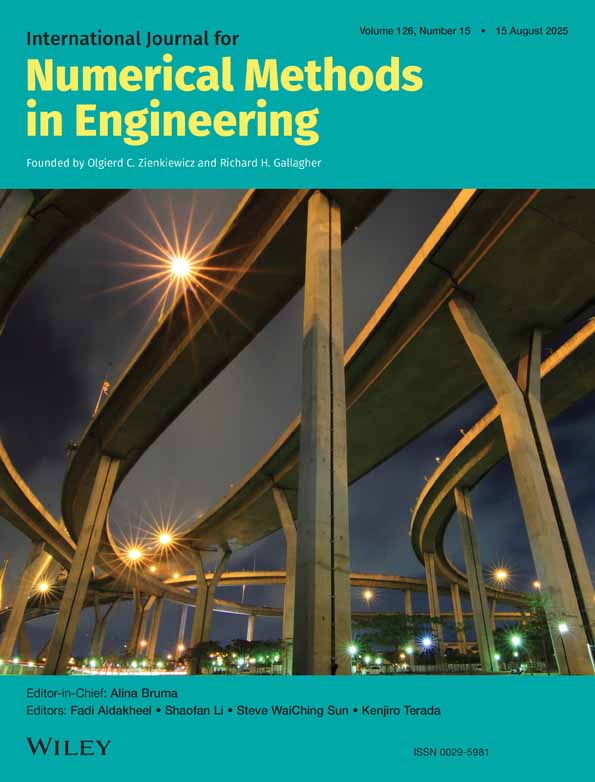Article
Full Access
Variational analysis of a slender fluid–structure system: The elasto-acoustic beam—a new symmetric formulation
R. Ohayon,
R. Ohayon
Office National d'Etudes et de Recherches Aérospatiales (ONERA), Chatillon, France
Search for more papers by this authorR. Ohayon,
R. Ohayon
Office National d'Etudes et de Recherches Aérospatiales (ONERA), Chatillon, France
Search for more papers by this authorAbstract
We present a new finite element analysis of the linear dynamic responses of a slender fluid–structure system, namely the elasto-acoustic beam, neglecting flow and viscosity effects. Using one unknown field in the fluid, namely the ‘mass–flow’ corresponding to a cross-section mean value of the longitudinal displacement field component, an original symmetric formulation is derived which does not exhibit the usual spurious modes associated with the irrotationality constraint occurring in displacements formulations of fluid–structure problems.
References
- 1 M. P. Paidoussis and N. T. Issid, ‘Dynamic stability of pipes conveying fluid’, J. Sound and Vib., 33 (3), 267–294 (1974).
- 2 P. J. Holmes, ‘Bifurcations to divergence and flutter in flow-induced oscillations: a finite dimensional analysis’, J. Sound and vib., 53 (4), 471–503 (1977).
- 3 S. S. Chen, ‘ Flow-induced vibration and instability of some nuclear reactor system components’. Proc. SMIRT - 7 Conf., Vol. B ( T. Belytschko and J. Donea, Eds.), North-Holland, Amsterdam, 1983.
- 4 G. Ordonneau, ‘Utilisation des matrices de transfert pour l'étude du comportement élasto-acoustique d'une canalisation avec écoulement interne: Application au calcul de la stabilité Pogo d'un lanceur à liquides’, Proc. Colioque Tendances actuelles en calcul des structures (Ed. Pluralis). Bastia, Corse, 1985.
- 5 F. Axisa and R. F. Gibert, ‘Nun-linear analysis of fluid–structure coupled transients in piping systems’, Proc. ASME–PVP Conf., Vol. 63, 1982.
- 6 M. El-Raheb, ‘Coupled shell-type frequency response of piping system composed of straight segments and elbows enclosing an acoustic medium’, Proc. ASME Conf. on Advances in Fluid-Structure Interaction, AMD, 64, PVP, 78, 141–144 (1981).
- 7 G. C. Everstine, ‘Dynamic analysis of fluid-filled piping systems using finite element techniques’, Proc. ASME Conf. on Advances in Fluid–Structure Interaction, AMD, 64, PVP, 78, 125–139 (1984).
- 8 T. B. Belytschko and U. Schumann, ‘Fluid–structure interaction in light water reactor systems’, Nucl. Eng. Design J., 60, 173–195 (1980).
- 9 O. C. Zienkiewicz and P. Bettess, ‘ Fluid–structure interaction’, Proc. Ocean Dynamics Symp., Oregon State University, Corvalis, Oregon, 1982.
- 10 O. C. Zienkiewicz, ‘ Coupled Problems and their numerical solution’, in Numerical methods in Coupled Systems ( R. W. Lewis, P. Bettess and E. Hinton, Eds.), Wiley, London and New York, 1984, pp. 35–58.
- 11 H. Morand and R. Ohayon, ‘ Symmetric variational formulations for the elasto-acoustic vibration problem. Finite element results’, Proc. 2nd Int. Symp. Finite El. Meth. in Flow Problems, ICCAD Series No. 2/6, Santa-Margherita, Italy, June 1976, STP ONERA 1976-32.
- 12 Y. S. Shin and M. K. Chargin, ‘ Acoustic responses of coupled fluid–structure system by acoustic-structural analogy’, Shock Vib. Bull., 1983.
- 13 O. C. Zienkiewicz and R. E. Newton, ‘ Coupled vibrations of a structure submerged in a compressible fluid’. Int. Symp. on Finite Element Techniques, Stuttgart, 1–15 May, 1969.
- 14 G. C. Everstine, ‘A symmetric potential formulation for fluid structure interactions’, J. Sound Vib., 79 (1), 157–160 (1981).
- 15 L. G. Olson and K. J. Bathe, ‘Analysis of fluid–structure interactions. A direct symmetric coupled formulation based on the fluid velocity potential’, Comp. Struct. J., 21 (1–2), 21–32 (1985).
- 16 H. Morand and R. Ohayon, ‘Substructure variational analysis for the vibrations of coupled fluid–structure systems’, Int. j. numer. methods Eng., 14 (5), 741–755 (1979).
- 17 R. Ohayon and R. Valid, ‘ True symmetric variational formulations for fluid–structure interaction in bounded domains. Finite element results’, in Numerical Methods in Coupled Systems ( R. W. Lewis, P. Bettess and E. Hinton, Eds.), Wiley, London and New York, 1984, pp. 35–58.
- 18 R. Ohayon, ‘ Transient and modal Analysis of bounded medium fluid–structure problems’, Proc. Int. Conf. on Num. Meth. for Transient and Coupled Problems, Venice, Italy, TP-ONERA No. 1984–56 ( R. W. Lewis, E. Hinton and P. Bettess, Eds.), Pineridge Press, Swansea, 1984 (extended versions to appear).
- 19
M. Geradin,
G. Roberts and
A. Huck,
‘Eigenvalue analysis and transient response of fluid–structure interaction problems’,
Eng. Comp.,
1,
151–160
(1984).
10.1108/eb023569 Google Scholar
- 20 C. A. Felippa, ‘Symmetrization of the contained compressible-fluid vibration eigenproblem’, Comm. Appl. Numer. Methods, 1, 241–247 (1985).
- 21 O. C. Zienkiewicz, The Finite Element Method, 3rd edn, McGraw-Hill, London, 1977.
- 22
J. T. Oden and
J. N. Reddy,
Variational Methods in Theoretical Mechanics,
2nd edn,
Universitext.
Springer-Verlag,
Berlin,
1983.
10.1007/978-3-642-68811-9 Google Scholar
- 23 R. Valid, Mechanics of Continuous Media and Analysis of Structures, North-Holland, Amsterdam. 1981.
- 24 F. J. Hatfield, D. C. Wiggert and L. C. Davidson, ‘Experimental validation of the component synthesis method for predicting vibration of liquid-filled piping’, Shock Vibration Bull., 54 (1984).
- 25 K. J. Bathe and C. A. Almeida, ‘A simple and effective pipe elbow element-linear analysis’, J. Appl. Mech., 47, 93–100 (1980).
- 26 W. K. Liu and H. G. Chang, ‘A method of computation for fluid–structure interaction’, Comp. Struct. J., 20 (1–3), 311–320 (1985).
- 27 C. Y. Wang, ‘Shaps—2: a three-dimensional computer program for linear/non linear static/dynamic analysis of piping systems’, Proc. ASME-PVP Conference, PVP, 98–7, 195–206 (1985).
- 28 N. Piet, ‘ A finite analysis of an elasto-acoustic beam taking into account flow and viscosity effects’, ONERA Technical Report (to appear).




